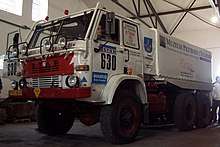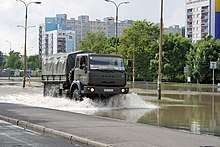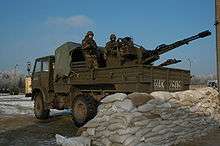Star 266
The Star 266 is a Polish 6x6 truck designed for transport of cargo and personnel. Created by Starachowice-based FSC Star, it was the basic transport truck used by the Polish Army, it was also available to civilian market. A successor to a highly successful Star 660 series of trucks, the Star 266 shared many components with earlier models, including Star 200 and Star 244 multi-purpose medium-capacity trucks.
| Star 266 | |
|---|---|
 | |
| Overview | |
| Manufacturer | FSC Star |
| Production | 1973 - 2000 |
| Assembly | Poland |
| Body and chassis | |
| Class | 6x6 Truck |
| Related | Star 200, Star 244 |
| Powertrain | |
| Engine | STAR 359/359M 6-cylinder diesel 150 hp |
| Transmission | S5-45 5-speed |
| Dimensions | |
| Curb weight | 7.35 tonnes |
| Chronology | |
| Predecessor | Star 660 |
| Successor | Star 1466 |
The truck could transport up to 3500 kilograms (7716 lbs) cross-country and up to 5000 kg (11023 lbs) on paved roads, it could also tow trailers of up to 4000 kg (8818 lbs). As a truck designed primarily with military service in mind, it can ford rivers and mud of between 120 and 180 centimetres of depth. It was initially equipped with a 6-cylinder S359 diesel engine (6842 cm³, 150 HP).
The design works started in 1968. The following year the first prototypes were ready. Between 1970 and 1973 the vehicle was being prepared to enter serial production which it did in 1973. It remained in production until 2000, when it was replaced with Star 1466. It was being produced for 27 years.
Usage

Star 266 was first all adopted as a basic military tactical truck, but was also used as civilian truck, especially for services needing high mobility, like a mobile workshop for energetics. It also served as a basis for several civilian vehicles including fire engines and truck-mounted cranes. Fire Engines and Energetic Services still use this Truck because of its durability and ease of repairs in poor weather and terrain conditions.
Two specially modified Star 266 trucks took part in the 1988 Dakar Rally. One crew included Tomasz Sikora and Jerzy Franek, second crew consisted of Jerzy Mazur and Julian Obornicki. Both trucks reached the finish line in Senegal but they went over the delay limit and as such they were disqualified.[1] One of the trucks is currently in Muzeum Przyrody i Techniki (Nature and Technology Museum) in Starachowice, home town of the truck.


Star 266 is a basic medium-capacity transport vehicle of the Polish Armed Forces and as such is used for a number of different tasks. Polish Army also uses the modernized variant of Star 266 known as Star 266M. Star 266 also served as basis for a number of different vehicles including CD-5 tanker trucks which are used for transport of liquid fuel by supply platoons of tank and mechanized battalions, GD-2 smokescreen generation vehicles, truck-mounted cranes, excavators, WUS-3 and IRS special vehicles used for disinfection and chemical recon, deactivation and decontamination of vehicles, terrain, equipment and buildings, ADK-11 command vehicles as well as Star-266 AP-64 and Star-266 BP-64 special transport vehicles used for transporting the elements of the PP-64 Wstęga pontoon bridge.[2][3][4]
Variants


- Star 266 - standard production model.
- Star 266M - modernized 266.
- Star 266 based military truck-mounted crane with 5 tonnes capacity.
- Star 266 based military excavator.
- GD-2 - military smokescreen generation vehicle used for creating constant or temporary smokescreens with maximal dimensions of 1500x150 m. Also known as typ 528.[2][4]
- CD-5 - military tank truck used for transport of liquid fuel by supply platoons of tank and mechanized battalions. It's equipped with a 4500-liter tank and a pump. Also known as typ 520.[2][3][4]
- Hibneryt - The Hibneryt is a Polish armored radar-directed self-propelled anti-aircraft gun system mounted on the Star 266 chassis.
- WUS-3 - military special vehicle used for disinfection, deactivation and decontamination of vehicles, terrain, equipment and buildings.[2][3][4]
- IRS (IRS stands for Instalacja Sanitarno-Rozlewcza) - military special vehicle used for disinfection, deactivation and decontamination of vehicles, terrain, equipment and buildings.[2][3][4]
- ADK-11 - military command and staff vehicle used as a part of the Topaz artillery fire direction system.[2][4]
- Star-266 AP-64 - military special transport vehicle used for transporting the elements of the PP-64 Wstęga pontoon bridge.[2][3][4]
- Star-266 BP-64 - military special transport vehicle used for transporting riverbank side pontoons of the PP-64 Wstęga pontoon bridge. Has an enlarged cabin with space for up to four soldiers.[2][3][4]
Military operators
- Polish Army - Produced and Used here.
- Angolan Armed Forces - 2785 (delivered between 1977 and 1981)[5] They were delivered during time when USSR were preparing to invade Afghanistan.
- Burmese Armed Forces - 106 (1990)[5]
- Hungarian Defence Force - 174 (1986–1989)[5] Given or Sold in terms of Technological exchange.
- Lithuanian Army - some Star 266 were donated by Poland[6]
- New Iraqi Army - Status unknown
- Military of Yemen - 400 (1999–2000)[5]
- Libyan Army - 650 (1986)[5]
- Soviet Army - 394 (1987–1989)[5] Given to USSR by Polish Military in terms of technological exchange.
- South African Army - captured in Angola[5]
References
| Wikimedia Commons has media related to Star 266. |
- STAR & JELCZ w rajdzie DAKAR
- Militarium.net Archived 2010-06-12 at the Wayback Machine
- softland
- Vademecum Militarne
- Brach, Jarosław (in Polish). Star 266 - projekty modernizacji. Część I in: „Nowa Technika Wojskowa” Nr. 4/2018, p. 49-50
- http://www.militis.pl/armie-owiata/sily-zbrojne-litwy-lotwy-i-estonii